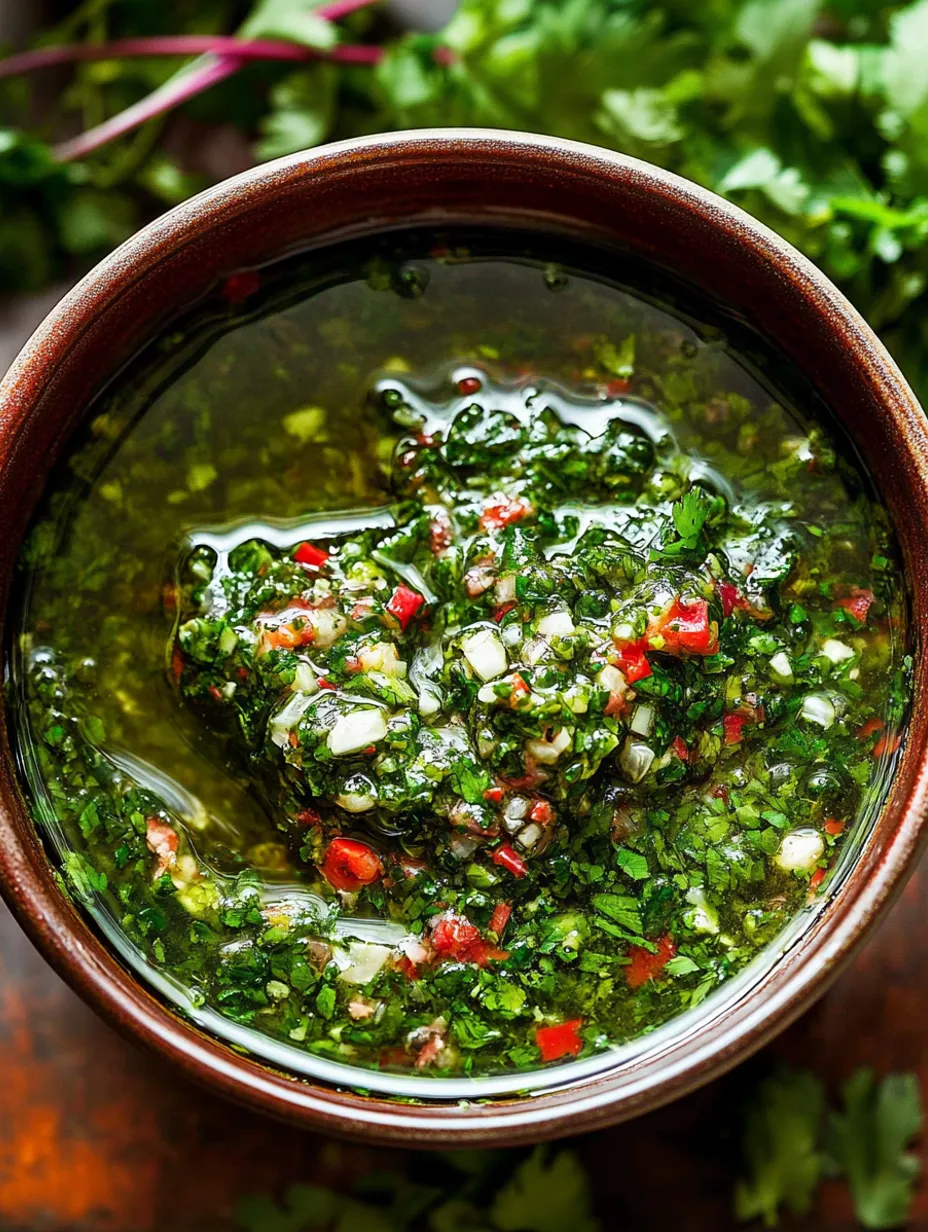 Save
Save
The aroma of chimichurri sends me back to being 8 years old, sitting at our rickety kitchen table watching Dad slice parsley into tiny bits like his life depended on it. He'd stand there, slightly bent over, his Uruguayan accent growing stronger as he shared tales about his childhood in Montevideo. "En mi país," he'd begin, and I knew we were about to hear something good.
My father picked up his chimichurri skills from my grandpa back in the 1930s, during weekend asados where neighbors gathered and everyone brought something for the grill. Chimichurri wasn't anything fancy they purchased – it was just the sauce you whipped up for your meat. Similar to how Americans always have ketchup on hand, my dad's family kept chimichurri in the kitchen at all times.
During last summer, Dad's health went downhill, but on one of his better days, we made chimichurri together. His hands were too shaky for chopping, so he sat and guided me like some herb-obsessed cooking show host. "Más fino!" (Finer!) he'd shout when my parsley chunks were too large. When I finished, he dipped his pinky in, sampled it, and simply nodded. Coming from him, that's practically a standing ovation.
The Authentic Components
- Flat-Leaf Parsley - Skip the curly type that shows up as pointless garnish on restaurant plates. Go for the flat kind with actual flavor. And don't toss those tender stems – they pack taste too.
- Garlic - Must be fresh. Those jars of pre-minced stuff might save time, but they lack any real flavor. Dad would rather skip it altogether than use pre-chopped garlic – that's how important this is.
- Dried Oregano - Strangely, the dried version works better than fresh here. Something about how it blends into the oil. Just check that it still has a scent when you open the container (odorless means it's ancient and basically useless).
- Red Wine Vinegar - Don't swap this for balsamic, white, or whatever's handy. Red wine vinegar offers the perfect tang without stealing the show.
- Fresh Red Chili - My dad would tweak the spiciness depending on his dinner guests. More heat for his card-playing buddies, milder when neighbors brought kids over. No fresh chilies around? Red pepper flakes will do.
- Olive Oil - No need for the premium stuff, but maybe don't use the everyday cooking oil either. Something from the middle shelf works fine.
- Salt and Black Pepper - Dad always added these gradually. "You can pour more in," he'd remind me, pointing with a wooden spoon, "but you can't fish it out." I heard this roughly 10,000 times while growing up.
 Save
Save
Simple Preparation Steps
Manual ChoppingForget the food processor and ignore the blender. Dad would go crazy if he caught anyone turning chimichurri into mush. Real chimichurri has distinct texture – small bits of herbs and garlic floating in oil, not green paste. Yes, it takes more time. No, there's no workaround. Just grab your knife and get chopping.
Dry Stuff FirstPut your chopped parsley, garlic, and chili in a bowl. Toss in your dried oregano, rubbing it between your fingers as you add it (this releases the oils inside the herbs). Add a bit of salt and pepper – go light with the salt for now; you can always add more.
Wet Ingredients NextAdd the vinegar, stir everything, then slowly pour in your olive oil while mixing. You don't need fancy techniques here – just make sure everything gets mixed somewhat equally.
Hurry Up and WaitThe toughest part of making chimichurri isn't the prep – it's waiting before you eat it. Freshly made chimichurri tastes good, but chimichurri that's rested for a couple hours tastes amazing. Dad always prepared his the morning before an asado. At the very least, let it sit for 10 minutes, but if you can wait 2+ hours, you'll be glad you did.
Taste TestBefore you serve it, dunk some bread in and try it. Needs more salt? Add some. More heat? Throw in extra chili. Following the exact measurements matters less than making it taste right to you.
Dad's chimichurri jar was practically a living thing. He kept adding fresh batches on top of the old stuff, claiming that the remains at the bottom were "seasoning" the new mix. I'm pretty sure this breaks every food safety guideline out there, but he never got ill and insisted it tasted better. I'm not suggesting you do this, just sharing the odd traditions of family cooking.
Ways To Enjoy This Sauce
Transform an average steak by adding chimichurri during the final minute of grilling, then serving extra on the side. The heat makes the herbs release this incredible smell that'll have your neighbors suddenly dropping by to "just say hello." Dad used to joke you could judge how good the cookout would be by counting how many stray dogs appeared at the fence when the chimichurri hit the hot grill.
Got friends who don't eat meat? Roast a batch of sweet potatoes, bell peppers, zucchini, whatever veggies you like, then drizzle chimichurri over them while still hot. The vinegar balances the sweetness of the roasted vegetables, and suddenly plain veggies steal the show. I found this out by accident when my fridge only had vegetables and chimichurri, and now I do it all the time.
Make your next dinner gathering look impressive by toasting baguette slices, spreading them with goat cheese, and adding a small spoonful of chimichurri. Everyone will think you're super fancy when really it took three minutes to put together. My go-to trick when I need to bring something to a potluck but have zero prep time.
Creative Variations
For something different, try chimichurri rojo by adding smoked paprika and some diced roasted red peppers. It's richer and smokier, pairs wonderfully with pork and chicken. Not what my dad would make, but even he admitted it tasted good when I made it for him.
Herb SwapThe classic uses only parsley, but you can mix in some cilantro if you like that flavor. Dad would give me a disapproving look for mentioning this, but he also often said, "La cocina es para experimentar" (the kitchen is for experimenting).
Citrus KickI sometimes replace half the vinegar with lemon or lime juice, especially when serving with fish. Dad would probably mumble about this not being "proper" chimichurri, but then he'd eat it anyway and pretend not to enjoy it while taking seconds.
Storage Tips
Counter TimeFresh chimichurri can stay on the counter, covered, all day if you're using it for dinner. The olive oil works as a natural preservative, and the vinegar's acidity helps too.
If you've got extra, pop it in a jar in the fridge for up to a week. The oil might get a bit solid when cold – this scared me the first time, but it's completely normal. Just take it out 30 minutes before you need it and mix well.
Green to BrownYour vibrant green sauce will likely darken after a day or two. It's just oxidation, similar to a sliced apple turning brown. Doesn't change the taste at all, so don't worry.
Freezer HackIf you've made tons extra, freeze it in an ice cube tray, then move the cubes to a freezer bag. Take them out whenever you want a quick flavor boost for soups, stews, or marinades. Not as perfect as fresh for serving straight, but great for cooking.
 Save
Save
Dad's Inside Knowledge
Size MattersTry to cut your parsley and garlic pieces about the same size. Nobody wants to bite into a surprise chunk of raw garlic bigger than they expected.
Quality ControlWith so few ingredients, freshness really does matter. This doesn't mean pricey, just flavorful and fresh.
Heat ActivationAlways put chimichurri on warm food, not cold dishes. The warmth brings out all the flavors in the herbs and garlic. Dad would get so upset if he saw anyone putting cold chimichurri on cold meat.
At our family reunion last month, I brought a huge batch of Dad's chimichurri. My uncle Miguel, who came to America in the 70s and hasn't returned to Uruguay since, took one bite with his steak and went quiet. I thought something was wrong until I noticed him dabbing his eyes with his napkin. "Esto," he said, pointing to the chimichurri, "esto es mi infancia." This is my childhood. That's what's special about food – sometimes it's more than just a meal, it's a journey back in time. I'm happy I can share a small piece of our family history with you.
Recipe FAQs
- → How long will chimichurri stay fresh?
- You can keep it in the fridge for up to a week in a sealed container. If the olive oil hardens, let it warm to room temperature before using. It's even tastier the next day!
- → Can a food processor be used for chimichurri?
- Sure, it's faster, but hand-chopping gives a chunkier feel and keeps the herbs from getting overworked, which can make them taste more bitter or lose texture.
- → What sets Argentinian chimichurri apart from Uruguayan?
- Uruguayan recipes go bigger on red pepper or include paprika. Argentinian ones may have cilantro sometimes, though the focus is still on parsley in both styles.
- → Can I skip the chilies?
- Absolutely! You can leave them out for a gentler flavor. The core taste comes from parsley, garlic, and olive oil. Add a pinch of red pepper flakes if you want just a touch of heat.
- → What meats are chimichurri's best match?
- It's a classic pair for grilled steaks like skirt or flank, but it’s just as amazing with chicken, pork, lamb, fish, or barbecue favorites like chorizo.
South American chimichurri
An herby and zesty South American sauce with parsley, garlic, red chilies, and olive oil. Perfect to drizzle over meat or toss into salads.
Ingredients
→ Main Ingredients
Steps
Toss everything into a bowl, then give it a good mix until it looks well blended.
Leave the mixture to sit for 5-10 minutes so the flavors can meld into the oil. If you're not rushed, let it sit for a couple of hours for an even deeper flavor.
If needed, you can make chimichurri ahead and store it in the fridge for up to a day.
Brush it over meats like steak or chicken while grilling. Spoon some over cooked meats when serving, or try it as a zesty salad dressing.
Notes
- In Uruguay and Argentina, chimichurri is commonly used as a basting sauce or served on the side, though you can marinate with it if you'd like.
- Adjust the seasoning—like chili, pepper, or salt—to match how you like it best.
- For the freshest taste, stick to fresh ingredients, especially parsley and garlic.
Required Tools
- A bowl for mixing
- Sharp knife and cutting surface
- Measuring tools, like cups and spoons
- Storage container with a tight-fitting lid
Allergy Information
Check each ingredient for potential allergens and consult a healthcare professional if needed.
- Typically safe, but some people could react to garlic or spicy chilies.
Nutritional Facts (per serving)
These details are provided for informational purposes and aren't a substitute for medical advice.
- Calories: 128
- Fats: 14 g
- Carbohydrates: 2 g
- Proteins: 0.4 g
